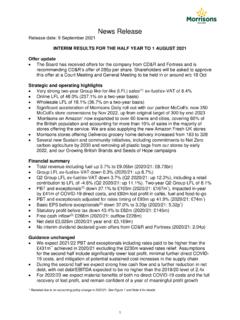Transcription of POCKET GUIDE Preventing Falls in Older Patients
1 Preventing Falls in Older PatientsCenters for Disease Control and Prevention National Center for Injury Prevention and Control2019 POCKET GUIDEKey Facts About Falls One in four Older adults age 65+ Falls every year. Falls are the leading cause of injury deaths for Older adults. Many Patients who have fallen do not bring it up at medical appointments, so providers need to year, ask your Older Patients : Have you fallen in the past year? Do you feel unsteady when standing or walking? Do you worry about falling?STEADI Resources for Your Patients Help Patients understand their own unique fall risk. Educate Patients on their modifiable risk factors and corresponding fall prevention strategies. Emphasize that fall prevention can help them remain independent. Discuss with Patients which strategies they might be willing to do. Work with Patients and caregivers to develop a plan for fall patient-friendly brochures: Stay Independent Postural Hypotension: What it is & How to Manage it Check for Safety What YOU Can Do to Prevent FallsFor more patient and provider resources, visit With Your Patients About FallsStopping Elderly Accidents,Deaths & InjuriesSTEADI Algorithm for fall Risk Screening, Assessment, and Intervention among Community-Dwelling Adults 65 years and olderSTARTHEREA vailable fall Risk Screening Tools: Stay Independent: a 12-question tool [at risk if score 4] -Important: If score < 4, ask if patient fell in the past year (If YES patient is at risk) Three key questions for Patients [at risk if YES to any question] -Feels unsteady when standing or walking?
2 -Worries about falling? -Has fallen in past year? If YES ask, How many times? Were you injured? 1 Educate patient on fall prevention Assess vitamin D intake -If deficient, recommend daily vitamin D supplement Refer to community exercise or fall prevention program Reassess yearly, or any time patient presents with an acute fallSCREENED AT RISKSCREENED NOT AT RISKC ommon ways to assess fall risk factors are listed below:Below are common interventions used to reduce fall risk:2 INTERVENE to reduce identified risk factors using effective gait, strength, & balance observed Refer for physical therapy Refer to evidence-based exercise or fall prevention program ( , Tai Chi)Medication(s) likely to increase fall risk Optimize medications by stopping, switching, or reducing dosage of medications that increase fall riskHome hazards likely Refer to occupational therapist to evaluate home safetyOrthostatic hypotension observed Stop, switch, or reduce the dose of medications that increase fall risk Educate about importance of exercises ( , foot pumps) Establish appropriate blood pressure goal Encourage adequate hydration Consider compression stockingsVisual impairment observed Refer to ophthalmologist/optometrist Stop, switch, or reduce the dose of medication affecting vision ( , anticholinergics)
3 Consider benefits of cataract surgery Provide education on depth perception and single vs. multifocal lensesFeet/footwear issues identified Provide education on shoe fit, traction, insoles, and heel height Refer to podiatristVitamin D deficiency observed or likely Recommend daily vitamin D supplementComorbidities documented Optimize treatment of conditions identified Be mindful of medications that increase fall riskEvaluate gait, strength, & balanceCommon assessments: Timed Up & GoIdentify medications that increase fall risk( , Beers Criteria)Ask about potential home hazards( , throw rugs, slippery tub floor)Measure orthostatic blood pressure (Lying and standing positions)Common assessment tool: Snellen eye testAssess feet/footwearAssess vitamin D intakeIdentify comorbidities ( , depression, osteoporosis) 30-Second Chair Stand 4-Stage Balance TestSCREEN for fall risk yearly, or any time patient presents with an acute patient s modifiable risk factors and fall future risk by recommending effective prevention ways to improve patient receptiveness to the care plan and address barrier(s)FOLLOW UP with patient in 30-90 identified fall risk Discuss patient and provider health goals Develop an individualized patient care plan (see below)Check visual acuity
















